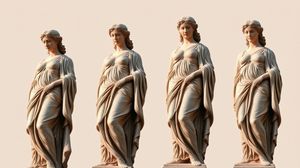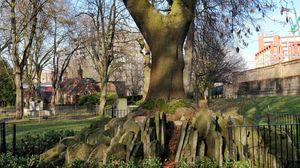
Located near the entrance of the British Library, the statue of Isaac Newton is a striking homage to one of history's most influential scientists. Designed by the acclaimed British artist Eduardo Paolozzi, the sculpture captures the essence of Newton's intellectual legacy. This imposing bronze statue depicts Newton in a larger-than-life, seated position, measuring over 20 feet high.
The statue draws its inspiration from a famous 18th-century engraving by William Blake. The depiction is intriguing as it portrays Newton in an unconventional manner, with the scientist intensely focused on mathematical calculations. This artistic representation challenges the typical solemn portrayals of scientists and philosophers, lending a unique narrative to the space it occupies.
Eduardo Paolozzi's decision to present Newton in Blake's mold reflects a nuanced interpretation of the often-contradictory nature of scientific inquiry and artistic expression. Visitors often find this juxtaposition compelling, as it offers a bridge between two distinct worlds through an unexpected yet harmonious design.
Installed in 1995, the statue stands as an iconic symbol not only of Newton's genius but also of the British Library's role in celebrating knowledge across disciplines. Its location in such a scholarly environment emphasizes the connection between Newton's groundbreaking works and the ongoing pursuit of knowledge and discovery.
The sculpture is an impressive display of Paolozzi's ability to transform weighty intellectual themes into tangible art that ignites curiosity. The detail in Newton's muscle structure and the mathematical tools in his hands invites onlookers to delve deeper into the story and impact of Newton's work.

Making the Most of Your Visit:
Take a moment to stand back and appreciate the sheer scale of the statue. At over 20 feet high, it's quite a spectacle, and seeing it from a distance lets you fully grasp the intricacies of Paolozzi's work, especially how it plays with proportion and dimension.
If you're interested in the interplay between art and science, consider doing a bit of background reading on William Blake's original engraving that inspired this sculpture. Not only does it give context to Paolozzi's piece, but it also highlights the fascinating relationship between these two figures from history.
Look closely at the details, especially the mathematical tools Newton holds. They aren't just artistic decorations but represent Newton's profound impact on mathematics and science. Spotting these details is like a mini treasure hunt and adds depth to your understanding of both the sculpture and Newton's legacy.
Visit at different times of the day if you can. The light changes the statue's mood, with morning light casting soft shadows, while the late afternoon sun highlights its metallic texture. It's intriguing seeing how the perception of the statue can shift with natural lighting.
Don't miss out on the chance to explore the British Library while you're here. It's not just about the books; there's often fascinating exhibitions that tie nicely with the themes of knowledge and discovery that the Newton statue represents.

Visiting Times & Costs:
The Isaac Newton Statue near the British Library in King's Cross is open to the public and accessible at any time, as it is located outdoors.
There is no entry fee to view the statue; it is free to visit.
Regarding accessibility, the statue is situated in a public outdoor space with pathways suitable for most visitors, including those using wheelchairs or pushchairs.

Address & Map:

Nearby:























